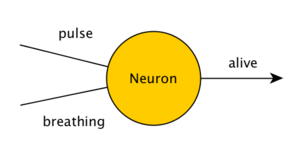Artificial neural network facts for kids
A neural network (also called an ANN or an artificial neural network) is a special type of computer program. It's designed to work a bit like a human brain. Just like your brain has tiny cells called neurons that work together to solve big problems, a neural network has many small parts that team up. Each part solves only a tiny piece of a larger puzzle. This teamwork helps create smart computer programs.
Neural networks are a cool example of machine learning. This means the program can actually change and get better as it learns from examples. A neural network can be trained and improved over time. However, the bigger the network, the more examples it needs to learn well. Sometimes, it needs millions or even billions of examples, especially in something called deep learning.
Contents
How Neural Networks Work
Imagine a neural network like a team of tiny workers. Each worker has a small job, but together they can do amazing things.
A network starts with an input, like a sensor taking in information. This information then travels through different layers of "neurons" inside the computer. Each computer neuron is connected to many others. If a neuron gets enough information, it sends a message to the neurons it's linked to.
In an artificial neural network, you have:
- An input layer where data comes in.
- One or more hidden layers where the main "thinking" happens.
- An output layer that gives the final answer.
Each tiny part (called a "node") in a hidden layer is connected to nodes in the next layer. When a node gets information, it processes it. Then it sends a certain amount of that information to the next nodes. The amount sent is decided by a special math rule called an "activation function." This function helps the network decide what to do with the information.
Think of it like this: A neural network is a series of math steps applied to the information it receives. The information at each step is like a list of numbers. Each pair of layers is connected by "weights." These weights are like strengths of connections. Each node also has "biases," which are like starting values. The network learns by adjusting these weights and biases.
The network also has a "cost function." This is like a score that tells the network how well it's doing its job. The goal is to make this score as low as possible. To do this, the network uses a technique called "optimization." This process changes the weights and biases little by little. This learning process is called training. After thousands of small training steps, the network usually becomes very good at its task.
A Simple Example
Let's think about a program that checks if a person is alive. It looks at two things: their pulse and their breath. If a person has a pulse OR is breathing, the program should say 'alive'. If they have neither, it should say 'dead'.
A very simple neural network, with just one neuron, could solve this problem.
For the computer, 'true' (yes) can be 1, and 'false' (no) can be 0.
- If the pulse is 0 (no) and breathing is 0 (no), the network should output 0 (dead).
- If the pulse is 1 (yes) and breathing is 0 (no), it should output 1 (alive).
- If the pulse is 0 (no) and breathing is 1 (yes), it should output 1 (alive).
- If the pulse is 1 (yes) and breathing is 1 (yes), it should output 1 (alive).
This neuron does a simple math step: it adds the pulse value and the breathing value. It also adds its own hidden value, called a 'bias'. At first, this bias is random. But the network adjusts it over time if it's not giving the right answer.
Sometimes, adding values can give numbers bigger than 1. But we want our output to be just 0 or 1! To fix this, the network uses a special function. This function makes sure the final output is always between 0 and 1. In more complex networks, this output (like 0.66) is then passed on to the next neuron until the final answer is ready.
How Neural Networks Learn
There are three main ways a neural network can learn:
- supervised learning: This is like learning with a teacher. The network is given examples with the correct answers. It tries to guess the answer, and then the "teacher" tells it if it was right or wrong. The network then adjusts itself to get better.
- unsupervised learning: This is like learning without a teacher. The network looks for patterns and structures in data all by itself, without being told what the right answers are.
- reinforcement learning: This is like learning through trial and error. The network tries different actions and gets "rewards" for good actions and "penalties" for bad ones. It learns to choose actions that get the most rewards.
Each of these learning methods is best for different kinds of tasks. For example, a research team from the University of Hertfordshire in the UK used reinforcement learning to teach an iCub humanoid robot to say simple words by babbling.
Images for kids
See also
 In Spanish: Red neuronal artificial para niños
In Spanish: Red neuronal artificial para niños



